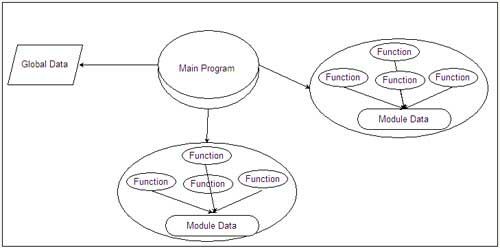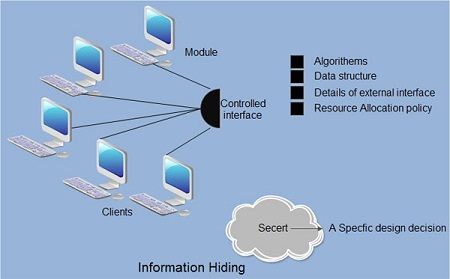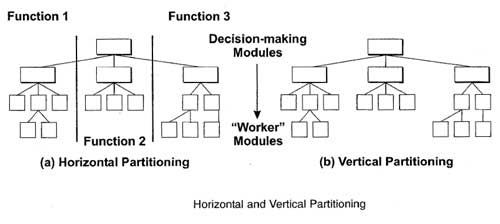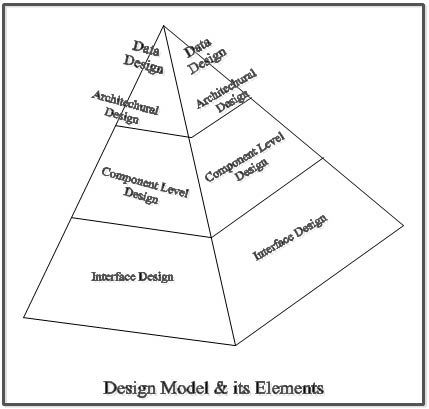Once the requirements document for the software to be developed is available, the software design phase begins. While the requirement specification activity deals entirely with the problem domain, design is the first phase of transforming the problem into a solution. In the design phase, the customer and business requirements and technical considerations all come together to formulate a product or a system.
The design process comprises a set of principles, concepts and practices, which allow a software engineer to model the system or product that is to be built. This model, known as design model, is assessed for quality and reviewed before a code is generated and tests are conducted. The design model provides details about software data structures, architecture, interfaces and components which are required to implement the system. This chapter discusses the design elements that are required to develop a software design model. It also discusses the design patterns and various software design notations used to represent a software design.
We’ll be covering the following topics in this tutorial:
Basic of Software Design
Software design is a phase in software engineering, in which a blueprint is developed to serve as a base for constructing the software system. IEEE defines software design as ‘both a process of defining, the architecture, components, interfaces, and other characteristics of a system or component and the result of that process.’
In the design phase, many critical and strategic decisions are made to achieve the desired functionality and quality of the system. These decisions are taken into account to successfully develop the software and carry out its maintenance in a way that the quality of the end product is improved.
Principles of Software Design
Developing design is a cumbersome process as most expansive errors are often introduced in this phase. Moreover, if these errors get unnoticed till later phases, it becomes more difficult to correct them. Therefore, a number of principles are followed while designing the software. These principles act as a framework for the designers to follow a good design practice.

Some of the commonly followed design principles are as following.
- Software design should correspond to the analysis model: Often a design element corresponds to many requirements, therefore, we must know how the design model satisfies all the requirements represented by the analysis model.
- Choose the right programming paradigm: A programming paradigm describes the structure of the software system. Depending on the nature and type of application, different programming paradigms such as procedure oriented, object-oriented, and prototyping paradigms can be used. The paradigm should be chosen keeping constraints in mind such as time, availability of resources and nature of user’s requirements.
- Software design should be uniform and integrated: Software design is considered uniform and integrated, if the interfaces are properly defined among the design components. For this, rules, format, and styles are established before the design team starts designing the software.
- Software design should be flexible: Software design should be flexible enough to adapt changes easily. To achieve the flexibility, the basic design concepts such as abstraction, refinement, and modularity should be applied effectively.
- Software design should ensure minimal conceptual (semantic) errors: The design team must ensure that major conceptual errors of design such as ambiguousness and inconsistency are addressed in advance before dealing with the syntactical errors present in the design model.
- Software design should be structured to degrade gently: Software should be designed to handle unusual changes and circumstances, and if the need arises for termination, it must do so in a proper manner so that functionality of the software is not affected.
- Software design should represent correspondence between the software and real-world problem: The software design should be structured in such away that it always relates with the real-world problem.
- Software reuse: Software engineers believe on the phrase: ‘do not reinvent the wheel’. Therefore, software components should be designed in such a way that they can be effectively reused to increase the productivity.
- Designing for testability: A common practice that has been followed is to keep the testing phase separate from the design and implementation phases. That is, first the software is developed (designed and implemented) and then handed over to the testers who subsequently determine whether the software is fit for distribution and subsequent use by the customer. However, it has become apparent that the process of separating testing is seriously flawed, as if any type of design or implementation errors are found after implementation, then the entire or a substantial part of the software requires to be redone. Thus, the test engineers should be involved from the initial stages. For example, they should be involved with analysts to prepare tests for determining whether the user requirements are being met.
- Prototyping: Prototyping should be used when the requirements are not completely defined in the beginning. The user interacts with the developer to expand and refine the requirements as the development proceeds. Using prototyping, a quick ‘mock-up’ of the system can be developed. This mock-up can be used as a effective means to give the users a feel of what the system will look like and demonstrate functions that will be included in the developed system. Prototyping also helps in reducing risks of designing software that is not in accordance with the customer’s requirements.
Note that design principles are often constrained by the existing hardware configuration, the implementation language, the existing file and data structures, and the existing organizational practices. Also, the evolution of each software design should be meticulously designed for future evaluations, references and maintenance.
Software Design Concepts
Every software process is characterized by basic concepts along with certain practices or methods. Methods represent the manner through which the concepts are applied. As new technology replaces older technology, many changes occur in the methods that are used to apply the concepts for the development of software. However, the fundamental concepts underlining the software design process remain the same, some of which are described here.
Abstraction
Abstraction refers to a powerful design tool, which allows software designers to consider components at an abstract level, while neglecting the implementation details of the components. IEEE defines abstraction as ‘a view of a problem that extracts the essential information relevant to a particular purpose and ignores the remainder of the information.’ The concept of abstraction can be used in two ways: as a process and as an entity. As a process, it refers to a mechanism of hiding irrelevant details and representing only the essential features of an item so that one can focus on important things at a time. As an entity, it refers to a model or view of an item.
Each step in the software process is accomplished through various levels of abstraction. At the highest level, an outline of the solution to the problem is presented whereas at the lower levels, the solution to the problem is presented in detail. For example, in the requirements analysis phase, a solution to the problem is presented using the language of problem environment and as we proceed through the software process, the abstraction level reduces and at the lowest level, source code of the software is produced.
There are three commonly used abstraction mechanisms in software design, namely, functional abstraction, data abstraction and control abstraction. All these mechanisms allow us to control the complexity of the design process by proceeding from the abstract design model to concrete design model in a systematic manner.
- Functional abstraction: This involves the use of parameterized subprograms. Functional abstraction can be generalized as collections of subprograms referred to as ‘groups’. Within these groups there exist routines which may be visible or hidden. Visible routines can be used within the containing groups as well as within other groups, whereas hidden routines are hidden from other groups and can be used within the containing group only.
- Data abstraction: This involves specifying data that describes a data object. For example, the data object window encompasses a set of attributes (window type, window dimension) that describe the window object clearly. In this abstraction mechanism, representation and manipulation details are ignored.
- Control abstraction: This states the desired effect, without stating the exact mechanism of control. For example, if and while statements in programming languages (like C and C++) are abstractions of machine code implementations, which involve conditional instructions. In the architectural design level, this abstraction mechanism permits specifications of sequential subprogram and exception handlers without the concern for exact details of implementation.
Architecture
Software architecture refers to the structure of the system, which is composed of various components of a program/ system, the attributes (properties) of those components and the relationship amongst them. The software architecture enables the software engineers to analyze the software design efficiently. In addition, it also helps them in decision-making and handling risks. The software architecture does the following.
- Provides an insight to all the interested stakeholders that enable them to communicate with each other
- Highlights early design decisions, which have great impact on the software engineering activities (like coding and testing) that follow the design phase
- Creates intellectual models of how the system is organized into components and how these components interact with each other.
Currently, software architecture is represented in an informal and unplanned manner. Though the architectural concepts are often represented in the infrastructure (for supporting particular architectural styles) and the initial stages of a system configuration, the lack of an explicit independent characterization of architecture restricts the advantages of this design concept in the present scenario.
Note that software architecture comprises two elements of design model, namely, data design and architectural design.
Patterns
A pattern provides a description of the solution to a recurring design problem of some specific domain in such a way that the solution can be used again and again. The objective of each pattern is to provide an insight to a designer who can determine the following.
- Whether the pattern can be reused
- Whether the pattern is applicable to the current project
- Whether the pattern can be used to develop a similar but functionally or structurally different design pattern.
Types of Design Patterns
Software engineer can use the design pattern during the entire software design process. When the analysis model is developed, the designer can examine the problem description at different levels of abstraction to determine whether it complies with one or more of the following types of design patterns.
- Architectural patterns: These patterns are high-level strategies that refer to the overall structure and organization of a software system. That is, they define the elements of a software system such as subsystems, components, classes, etc. In addition, they also indicate the relationship between the elements along with the rules and guidelines for specifying these relationships. Note that architectural patterns are often considered equivalent to software architecture.
- Design patterns: These patterns are medium-level strategies that are used to solve design problems. They provide a means for the refinement of the elements (as defined by architectural pattern) of a software system or the relationship among them. Specific design elements such as relationship among components or mechanisms that affect component-to-component interaction are addressed by design patterns. Note that design patterns are often considered equivalent to software components.
- Idioms: These patterns are low-level patterns, which are programming-language specific. They describe the implementation of a software component, the method used for interaction among software components, etc., in a specific programming language. Note that idioms are often termed as coding patterns.
Modularity
Modularity is achieved by dividing the software into uniquely named and addressable components, which are also known as modules. A complex system (large program) is partitioned into a set of discrete modules in such a way that each module can be developed independent of other modules. After developing the modules, they are integrated together to meet the software requirements. Note that larger the number of modules a system is divided into, greater will be the effort required to integrate the modules.

Modularizing a design helps to plan the development in a more effective manner, accommodate changes easily, conduct testing and debugging effectively and efficiently, and conduct maintenance work without adversely affecting the functioning of the software.
Information Hiding
Modules should be specified and designed in such a way that the data structures and processing details of one module are not accessible to other modules. They pass only that much information to each other, which is required to accomplish the software functions. The way of hiding unnecessary details is referred to as information hiding. IEEE defines information hiding as ‘the technique of encapsulating software design decisions in modules in such a way that the module’s interfaces reveal as little as possible about the module’s inner workings; thus each module is a ‘black box’ to the other modules in the system.

Information hiding is of immense use when modifications are required during the testing and maintenance phase. Some of the advantages associated with information hiding are listed below.
- Leads to low coupling
- Emphasizes communication through controlled interfaces
- Decreases the probability of adverse effects
- Restricts the effects of changes in one component on others
- Results in higher quality software.
Stepwise Refinement
Stepwise refinement is a top-down design strategy used for decomposing a system from a high level of abstraction into a more detailed level (lower level) of abstraction. At the highest level of abstraction, function or information is defined conceptually without providing any information about the internal workings of the function or internal structure of the data. As we proceed towards the lower levels of abstraction, more and more details are available.
Software designers start the stepwise refinement process by creating a sequence of compositions for the system being designed. Each composition is more detailed than the previous one and contains more components and interactions. The earlier compositions represent the significant interactions within the system, while the later compositions show in detail how these interactions are achieved.
To have a clear understanding of the concept, let us consider an example of stepwise refinement. Every computer program comprises input, process, and output.
- INPUT
- Get user’s name (string) through a prompt.
- Get user’s grade (integer from 0 to 100) through a prompt and validate.
- PROCESS
- OUTPUT
This is the first step in refinement. The input phase can be refined further as given here.
- INPUT
- Get user’s name through a prompt.
- Get user’s grade through a prompt.
- While (invalid grade)
Ask again:
- PROCESS
- OUTPUT
Note: Stepwise refinement can also be performed for PROCESS and OUTPUT phase.
Refactoring
Refactoring is an important design activity that reduces the complexity of module design keeping its behaviour or function unchanged. Refactoring can be defined as a process of modifying a software system to improve the internal structure of design without changing its external behavior. During the refactoring process, the existing design is checked for any type of flaws like redundancy, poorly constructed algorithms and data structures, etc., in order to improve the design. For example, a design model might yield a component which exhibits low cohesion (like a component performs four functions that have a limited relationship with one another). Software designers may decide to refactor the component into four different components, each exhibiting high cohesion. This leads to easier integration, testing, and maintenance of the software components.
Structural Partitioning
When the architectural style of a design follows a hierarchical nature, the structure of the program can be partitioned either horizontally or vertically. In horizontal partitioning, the control modules are used to communicate between functions and execute the functions. Structural partitioning provides the following benefits.
- The testing and maintenance of software becomes easier.
- The negative impacts spread slowly.
- The software can be extended easily.
Besides these advantages, horizontal partitioning has some disadvantage also. It requires to pass more data across the module interface, which makes the control flow of the problem more complex. This usually happens in cases where data moves rapidly from one function to another.

In vertical partitioning, the functionality is distributed among the modules–in a top-down manner. The modules at the top level called control modules perform the decision-making and do little processing whereas the modules at the low level called worker modules perform all input, computation and output tasks.
Concurrency
Computer has limited resources and they must be utilized efficiently as much as possible. To utilize these resources efficiently, multiple tasks must be executed concurrently. This requirement makes concurrency one of the major concepts of software design. Every system must be designed to allow multiple processes to execute concurrently, whenever possible. For example, if the current process is waiting for some event to occur, the system must execute some other process in the mean time.
However, concurrent execution of multiple processes sometimes may result in undesirable situations such as an inconsistent state, deadlock, etc. For example, consider two processes A and B and a data item Q1 with the value ‘200’. Further, suppose A and B are being executed concurrently and firstly A reads the value of Q1 (which is ‘200’) to add ‘100’ to it. However, before A updates es the value of Q1, B reads the value ofQ1 (which is still ‘200’) to add ’50’ to it. In this situation, whether A or B first updates the value of Q1, the value of would definitely be wrong resulting in an inconsistent state of the system. This is because the actions of A and B are not synchronized with each other. Thus, the system must control the concurrent execution and synchronize the actions of concurrent processes.
One way to achieve synchronization is mutual exclusion, which ensures that two concurrent processes do not interfere with the actions of each other. To ensure this, mutual exclusion may use locking technique. In this technique, the processes need to lock the data item to be read or updated. The data item locked by some process cannot be accessed by other processes until it is unlocked. It implies that the process, that needs to access the data item locked by some other process, has to wait.
Developing a Design Model
To develop a complete specification of design (design model), four design models are needed. These models are listed below.
- Data design: This specifies the data structures for implementing the software by converting data objects and their relationships identified during the analysis phase. Various studies suggest that design engineering should begin with data design, since this design lays the foundation for all other design models.
- Architectural design: This specifies the relationship between the structural elements of the software, design patterns, architectural styles, and the factors affecting the ways in which architecture can be implemented.
- Component-level design: This provides the detailed description of how structural elements of software will actually be implemented.
- Interface design: This depicts how the software communicates with the system that interoperates with it and with the end-users.

 Dinesh Thakur holds an B.C.A, MCDBA, MCSD certifications. Dinesh authors the hugely popular
Dinesh Thakur holds an B.C.A, MCDBA, MCSD certifications. Dinesh authors the hugely popular